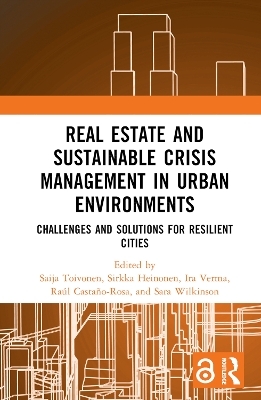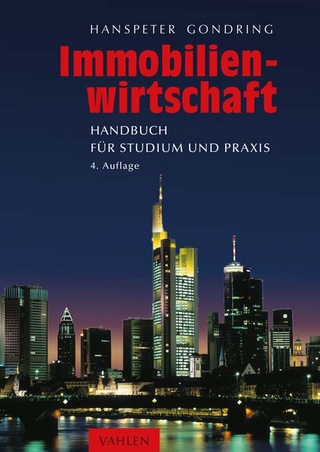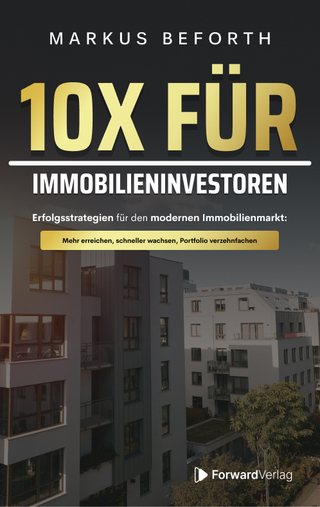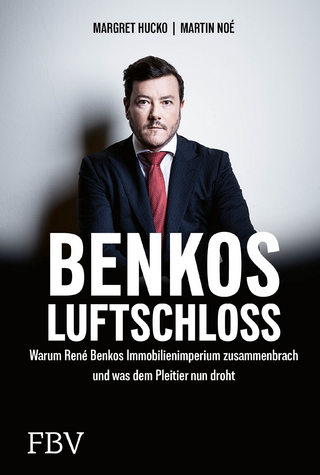
Real Estate and Sustainable Crisis Management in Urban Environments
Routledge (Verlag)
978-1-032-75570-0 (ISBN)
The aim of this book is to promote the dynamic resilience of societies by identifying, analysing, and exemplifying the role of space and land use in both anticipated and unanticipated primary and secondary crisis situations.
The book brings together the expertise of a unique team of researchers and methods from fields of futures studies, land use planning, social sustainability and wellbeing, architecture, spatial planning, design and real estate economics, and presents a novel understanding of the direct and indirect impacts of possible crises in the space and land use context. It goes on to discuss the concept of resilience and exemplifies potential solutions and offers a holistic and forward-looking approach for crisis management through a lens of social sustainability and wellbeing, making an important contribution to the promotion of wellbeing in the built environment, especially in terms of land and residential space and building use.
This book does not only identify barriers and successful incentives in resilient crisis management but also discusses the role of different stakeholders (e.g., households, office workers, real estate owners, space occupants, firms, the public sector, etc.) in crisis management. Finally, international case studies aiming to tackle the challenging landscape of future threats are presented, along with novel tools to support the development of future policies, regulations, and management practices in the built environment, which can increase the dynamic resilience of societies.
Overall, this book is essential reading for decision-makers in the public and private sectors, urban developers, space and spatial designers, architects, planners, community stakeholders, real estate investors, facility managers and crisis and corporate responsibility managers.
A PDF version of this book is available for free in Open Access at www. taylorfrancis.com. It has been made available under a Creative Commons Attribution 4.0 International license.
Saija Toivonen works as an assistant professor in Future Real Estate at the Department of Built Environment at Aalto University, Finland with a wide range of topics concerning the future real estate market environment. Her special interest is combining the future dimension into real estate market research, and she has been applying methods of futures studies in real estate and built environment context for nearly 20 years. Her research scope includes themes such as the future development of space- and land-related preferences, and the different forces of change including both megatrends, weak signals and wild cards, and the resulting real estate market dynamics. Her studies are aiming to develop solutions and strategies towards a more future conscious, sustainable and resilient real estate sector. Toivonen acts also as the Chair of The Finnish Association for Real Estate Valuation and as a board member of the Property Valuation Board of the Finland Chamber of Commerce which supervises the performance of authorized real estate appraisers in Finland. Saija is the consortium leader of the research project RESCUE and leads the work package which focuses on crisis identification and analysing their direct and indirect impacts. Professor Emerita Sirkka Heinonen has been with Finland Futures Research Centre (FFRC), University of Turku as professor of Futures Studies since 2007. Previously she was Chief Research Scientist at VTT Technical Research Centre of Finland since 1979. She holds a PhD degree from Helsinki University, with 40 years of research and teaching experience in futures studies, especially technology foresight and innovations, urban and rural futures, sustainable information society, media and journalism, and renewable energy and lifestyles. She is a Member of the Club of Rome (2005–), Co-Chair of the Helsinki Node of the Millennium Project (2001–), Guest Professor at the University of Science and Technology of China (USTC 2013–), Member of the Academy of Technical Sciences (2014–), and President (2012–2015), Vice-President (2016–) and Honorary Member (2020–) of the Finnish Society for Futures Studies. She is also a member of the board of editors for six scientific journals. She is member of the Chilean Council of Foresight and Strategy, and in the Philippine Futures Thinking Society. She has developed specific futures methodologies/processes such as Futures Clinique, Creative Foresight Space, Pioneer Analysis. Ira Verma (D.Sc. in Architecture) Senior Scientist, works in the RESCUE project in a work package focusing on how crises related to the built environment affect the social sustainability and wellbeing of people. The objective is to gain further understanding for improving community resilience. She has nearly 20 years of work experience of research and project management in the Research Group for Health and Wellbeing Architecture, SOTERA, at the Department of Architecture, Aalto University. She has been involved in various national and international projects related to housing for older people, user-centred design and Universal Design. Her doctoral dissertation was on these topics (Verma, I. 2019. Housing design for all? The challenges of ageing in urban planning and housing design – The case of Helsinki). Raúl Castaño is postdoctoral researcher in affordable and resilient housing at Tampere University and works on providing a better understanding on the key conditions to develop a more sustainable, affordable and resilient built environment through a human-centric approach. A major component of his work - and contribution to the field - has been to develop a novel model to assess the level of energy vulnerability (energy poverty) in residential buildings, supporting decision making toward a more sustainable, resilient, and affordable housing. Raúl is also actively involved in the ECIU University at the European level as Research Field Coordinator of the Resilient Communities of practices. Sara Wilkinson is a chartered building surveyor and Australia’s first female professor of property. Her transdisciplinary research program sits at the intersection of sustainability, urban development and transformation, with a focus on green cities and preparing our urban environments for the challenges of climate change and resilience. Current projects include development of a STAR (Sustainable Temporary Adaptive Reuse) Toolkit, a Bushfire Retrofit Housing Toolkit for older Australians, and the performance evaluation of hempcrete wall panels. Sara engages in trans-disciplinary research with colleagues from engineering, science, health, and business as well as built environment disciplines.
Foreword
Preface
Glossary
1. Introduction to Crises, Crisis Management, and Resilience in the Built Environment - Lassi Tähtinen
2. Crises and Wellbeing, the Potential of the Built Environment - Ira Verma
3. Resilience by Whom and for Whom? Empowering Local Communities for Community-led Resilience Building -Anahita Rashidfarokhi
4. A Mindshift Towards Futures Resilience and Anticipatory Urban Governance - Sirkka Heinonen, Joni Karjalainen and Amos Taylor
5. How Can Housing Design and Transformation Promote Resilience to Different Crises? - Raúl Castaño-Rosa, Sofie Pelsmakers, Heini Järventausta
6. Responding to Stress and Crisis. The Case of Social Resilience in Comprehensive Planning in Stockholm, Copenhagen and Helsinki - Johanna Liliius
7. Responding to Disruption in Built Environments – Lessons from Circular Thinking – Riikka Kyrö
8. The Sustainable Temporary Adaptive Reuse (STAR) Toolkit: A Solution for Underused and Vacant Buildings – Gill Armstrong, Sara Wilkinson, Kasul Nanayakkara, Robert Fleck, Mark Willers and Juanee Cilliers
9. Australian Case: Black Summer Bushfires - Mona Salam, Shuang Wu, Iina Lohi, Alison Wain, Robert Fleck, Sara Wilkinson, Saeed Banihashemi, Aso Hajirasouli and Lois Towart
10. Building Urban Resilience for Coastal Urban Communities: The Surprise of Tsunamis with Consideration of Human Factors – Azin Fathianpour, Mostafa Babaeian Jelodar, Barry Evans and Suzanne Wilkinson
11. The Resilient Urban Environment at All Levels and with All its Actors – Saija Toivonen
| Erscheinungsdatum | 04.06.2024 |
|---|---|
| Zusatzinfo | 9 Line drawings, black and white; 47 Halftones, black and white; 56 Illustrations, black and white |
| Verlagsort | London |
| Sprache | englisch |
| Maße | 156 x 234 mm |
| Gewicht | 589 g |
| Themenwelt | Naturwissenschaften ► Biologie ► Ökologie / Naturschutz |
| Naturwissenschaften ► Geowissenschaften ► Geografie / Kartografie | |
| Technik ► Bauwesen | |
| Wirtschaft ► Betriebswirtschaft / Management ► Rechnungswesen / Bilanzen | |
| Betriebswirtschaft / Management ► Spezielle Betriebswirtschaftslehre ► Immobilienwirtschaft | |
| ISBN-10 | 1-032-75570-9 / 1032755709 |
| ISBN-13 | 978-1-032-75570-0 / 9781032755700 |
| Zustand | Neuware |
| Informationen gemäß Produktsicherheitsverordnung (GPSR) | |
| Haben Sie eine Frage zum Produkt? |
aus dem Bereich


